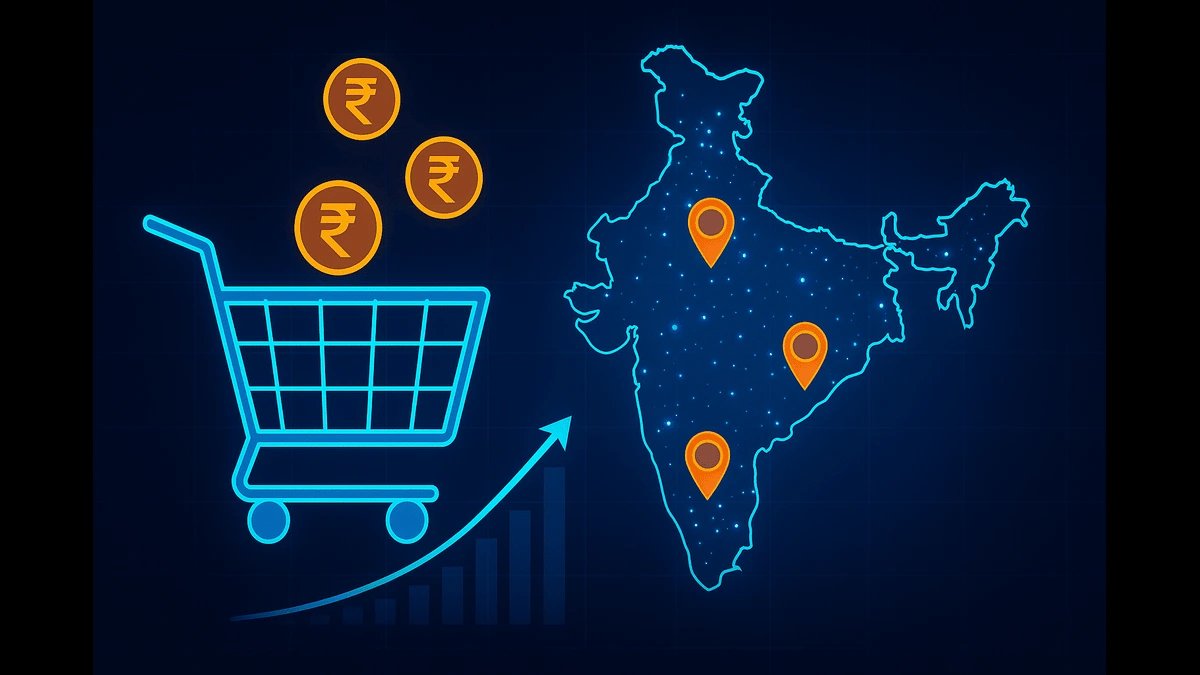
India’s $60B e-retail sector is set to hit $170–$190B by 2030, powered by Gen Z, UPI, and Tier-3 growth. Despite inflation and policy risks, digital retail is booming.
India’s e-retail market, valued at approximately $60 billion in 2024, ranks as the world’s second-largest in terms of online shoppers, surpassed only by China. Despite a recent decline in growth, projections indicate the market will reach $170–$190 billion by 2030, according to the “How India Shops Online 2025” report by Bain & Company and Flipkart. This expansion, driven by a compound annual growth rate (CAGR) exceeding 18%, is supported by advancements in digital infrastructure, evolving consumer demographics, and opportunities in smaller cities. Macroeconomic challenges persist, necessitating strategic adaptations by retailers. This analysis examines the factors shaping India’s e-retail sector, supported by authoritative data.
Current Market Dynamics: A $60 Billion Sector Facing Challenges
In 2024, India’s e-retail market achieved a gross merchandise value (GMV) of approximately $60 billion, driven by over 270 million online shoppers, as reported by the “How India Shops Online 2025” report. This establishes India as the second-largest e-retail market globally, ahead of the United States, with leading platforms including Amazon, Flipkart, and Meesho. However, annual growth has slowed to 10–12%, down from over 20% historically based on the same report.
This deceleration results from macroeconomic pressures. Consumption growth declined from 11% pre-Covid (2017–19) to approximately 8% post-Covid (2022–24), according to the Reserve Bank of India’s 2024 economic analysis. Urban markets, contributing 60% of e-retail GMV, face retail inflation of 5.5% in 2024, as per Ministry of Statistics and Programme Implementation. Stagnant real wages have limited discretionary spending, affecting categories such as electronics and fashion, which account for 30% of e-retail sales, as noted by Redseer Strategy Consultants.
Nevertheless, the sector’s fundamentals remain robust. Internet penetration reached 55% in 2024, with 820 million active users, per the Internet and Mobile Association of India (IAMAI). Affordable smartphones and data plans, averaging $0.15 per GB, have facilitated widespread online access, enabling rapid platform expansion.
Long-Term Growth Drivers: Targeting $170–$190 Billion by 2030
The “How India Shops Online 2025” report forecasts India’s e-retail market to grow to $170–$190 billion by 2030, propelled by structural strengths and strategic investments. The following factors are critical:
Digital Infrastructure and Payment Systems
India’s digital ecosystem underpins e-retail growth. The Unified Payments Interface (UPI) processed 1.5 billion daily transactions in 2024, per the National Payments Corporation of India (NPCI), ensuring seamless payments across urban and rural regions. Cash-on-delivery, used in 40% of transactions in Tier-3 and smaller cities, enhances accessibility, according to Redseer.
Logistics infrastructure has advanced significantly. E-commerce logistics providers Delhivery serves over 19,000 pin codes and Ecom Express serves close to 27,000 pin codes and also enable 1–2 day delivery in Tier-2 cities. Warehousing investments of $2 billion in 2024 have enabled same-day delivery in 20 major cities, as reported by CBRE India.
Expansion into Tier-3 and Smaller Cities
Tier-3 and smaller cities, representing 70% of India’s population, are key growth areas. Approximately 60% of new shoppers since 2020 and 60% of new sellers since 2021 originate from these regions, per the “How India Shops Online 2025” report. Cities such as Jaipur, Surat, and Coimbatore report 25% annual GMV growth, outpacing metropolitan areas, according to Redseer.
Localized strategies are essential. Meesho employs vernacular content and social commerce, with 80% of its 120 million users from Tier-3 and smaller cities. Amazon’s “I Have Space” program collaborates with over 15,000 kirana stores for last-mile delivery, per company data, fostering trust and access in these markets.
Evolving Consumer Demographics
India’s e-retail user base, exceeding 270 million, is increasingly youthful. Gen Z (born 1997–2012), comprising nearly 40% of e-retail customers, is digitally proficient and experimental. They prioritize value-driven products, sustainability, and multi-platform engagement across Instagram, WhatsApp, and e-commerce apps, with over 90% preferring UPI for payments, per the Bain report.
Gen Z drives category shifts. Lifestyle products (apparel, accessories) and groceries are projected to constitute two-thirds of the e-retail market by 2030, accounting for approximately 70% of incremental growth. Quick commerce platforms, such as Blinkit and Zepto, deliver in 10–20 minutes, meeting Gen Z’s demand for convenience. E-grocery orders represent over two-thirds of their volume and 10% of total e-retail spend in 2024.
Category-Specific Growth and Innovation
High-frequency categories—grocery, lifestyle, and general merchandise—drive e-retail expansion, with penetration expected to increase two- to fourfold by 2030, per the Bain report. The $600 billion offline grocery market reached 5% online penetration in 2024, with potential to hit 15% by 2030, per Deloitte. Platforms like BigBasket and JioMart offer over 50,000 SKUs, competing with physical retailers.
Quick commerce, projected to grow over 40% annually through 2030, extends to electronics and apparel (15–20% of q-commerce GMV). Zepto operates over 1,000 dark stores in 2024, per TechCrunch India, ensuring rapid delivery. Amazon’s AI-driven recommendations increase conversion rates by 15%, and Flipkart’s supply chain analytics reduce out-of-stock incidents by 20%, per company reports.
Trend-first commerce, particularly in fashion, is expected to quadruple to $8–$10 billion by 2028, with over half of sales online, per the Bain report. Platforms like Flipkart Spoyl and Myntra Fwd target Gen Z with affordable, trendy collections. Hyper-value commerce, led by Meesho, grew from 5% of e-retail GMV in 2021 to 12–15% in 2024, driven by low-cost offerings for Tier-3 and smaller city consumers.
Risk Factors and Structural Gaps in India’s E-Retail Sector
Despite its growth potential, India’s e-retail sector faces risks and structural challenges that could influence its trajectory by 2030.
The ONDC Disruption
The Open Network for Digital Commerce (ONDC), a government-backed initiative, promotes an open protocol enabling small sellers and local stores to transact directly with consumers, bypassing traditional platforms. As ONDC expands in Tier-2 and Tier-3 cities, it may challenge the dominance of Amazon, Flipkart, and Meesho, potentially reducing seller dependency and platform margins. Retailers must enhance value-added services to maintain competitiveness.
Data Privacy and Regulatory Headwinds
The Digital Personal Data Protection (DPDP) Act of 2023 imposes stringent regulations on user data collection, processing, and sharing. E-retail platforms, reliant on behavioral data for advertising, recommendations, and pricing, face increased compliance costs and complexity. Transparent data practices are critical to maintaining consumer trust as enforcement strengthens, requiring investments in consent management and secure data frameworks.
Urban Saturation and Slowing Tier-1 Growth
While Tier-2 and Tier-3 cities offer significant growth opportunities, Tier-1 urban markets, such as Delhi NCR, Mumbai, and Bangalore, are nearing digital saturation, with internet penetration exceeding 80%. Rising customer acquisition costs and slowing user growth in these cities shift focus to retention and wallet-share expansion. Categories like electronics and high-end fashion are plateauing due to market maturity and economic pressures, necessitating strategies focused on personalization and loyalty programs.
Future Outlook
India’s e-retail sector is poised for significant growth despite near-term challenges. Its core strengths—digital adoption, a youthful consumer base, and expansion into Tier-3 and smaller cities—support a projected $170–$190 billion valuation by 2030, with nearly 10% of retail spending online.
Retailers must prioritize innovation and inclusivity, leveraging AI, logistics, and vernacular content to access new markets while ensuring affordability and trust. For investors, India’s e-retail presents a compelling opportunity, driven by a billion-strong consumer base and a digital-first economy.
Led by platforms like Amazon, Flipkart, and Meesho, India’s e-retail sector is set to redefine retail, influencing global trends through 2030.
Read this report to know more in detail : How India Shops Online 2025
Discover more from Poniak Times
Subscribe to get the latest posts sent to your email.








